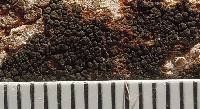
Consortium of Lichen Herbaria
- building a Global Consortium of Bryophytes and Lichens as keystones of cryptobiotic communities -
- Home
- Search
- Images
- Species Checklists
- US States: O-Z >
- US National Parks
- Central America
- South America
- US National Parks
- Southern Subpolar Region
|
|
|
|
Family: Verrucariaceae
|
Nash, T.H., Ryan, B.D., Gries, C., Bungartz, F., (eds.) 2002. Lichen Flora of the Greater Sonoran Desert Region. Vol 1. Thallus: squamulose squamules: small (c. 1-2 mm wide and 0.1-0.2 mm thick), densely imbricate in several layers, adnate, lobed upper surface: medium to dark brown, smooth, dull upper cortex: 20-30 µm thick, composed of angular cells (4-9 µm in diam.), overlain by a thin amorphous layer medulla: yellow, composed of densely interwoven hyphae divided into many spherical cells (5-9 µm in diam.), upper part densely inspersed with small crystals, (downwards less inspersed and darkening - thus merging into a thick dark basal layer); algal layer: averaging 50 µm in thickness, evenly delimited above, uneven below, horizontally continuous or slightly divided by vertical hyphal bundles; algal cells: c. 5-8 µm in diam. lower cortex: not developed lower surface: black, squamules attached by rhizohyphae; rhizohyphae: brownish, 3-5 µm thick Perithecia: subglobose, up to 0.25 mm broad, deeply sunken into the dark basal layer of squamules; exciple: black throughout, c. 25 µm thick; periphyses: 20-35 µm long; hymenial algal cells: globose, 3-5 (-6) µm in diam. asci: clavate, 70-80 x 15-20 µm, 2-spored ascospores: muriform, hyaline to slightly brownish, 25-30 x 12-15 / 32-40 x 11-13µm (distal/proximal spores) Pycnidia: immersed conidia: c. 5 x 1 µm Spot tests: all negative Secondary metabolites: none detected. Substrate and ecology: on rock World and Sonoran distribution: known only from the type collection in Sonora. Notes: Endocarpon myeloxanthum is the only species known to have a yellow medulla, apparently caused by crystaline inclusions which are clearly visible in microscopical sections of well-developed, thicker squamules under polarized light. The inspersed upper part of medulla may be very poorly developed or even lacking in thin squamules. |
Powered by Symbiota














